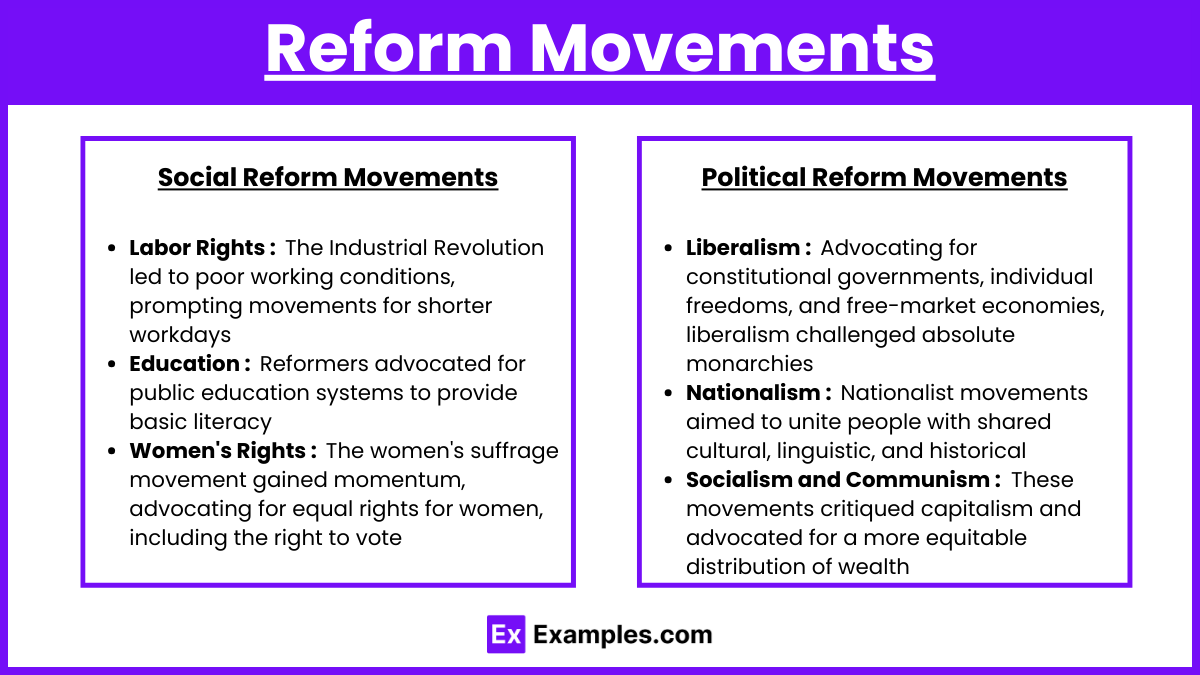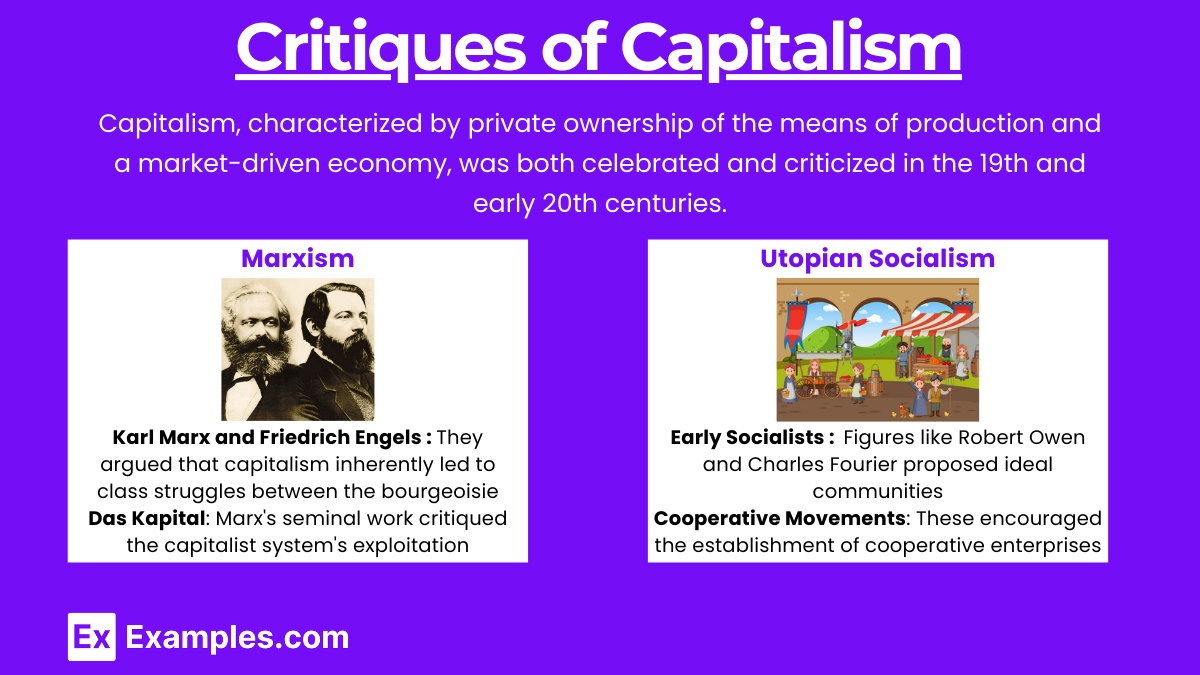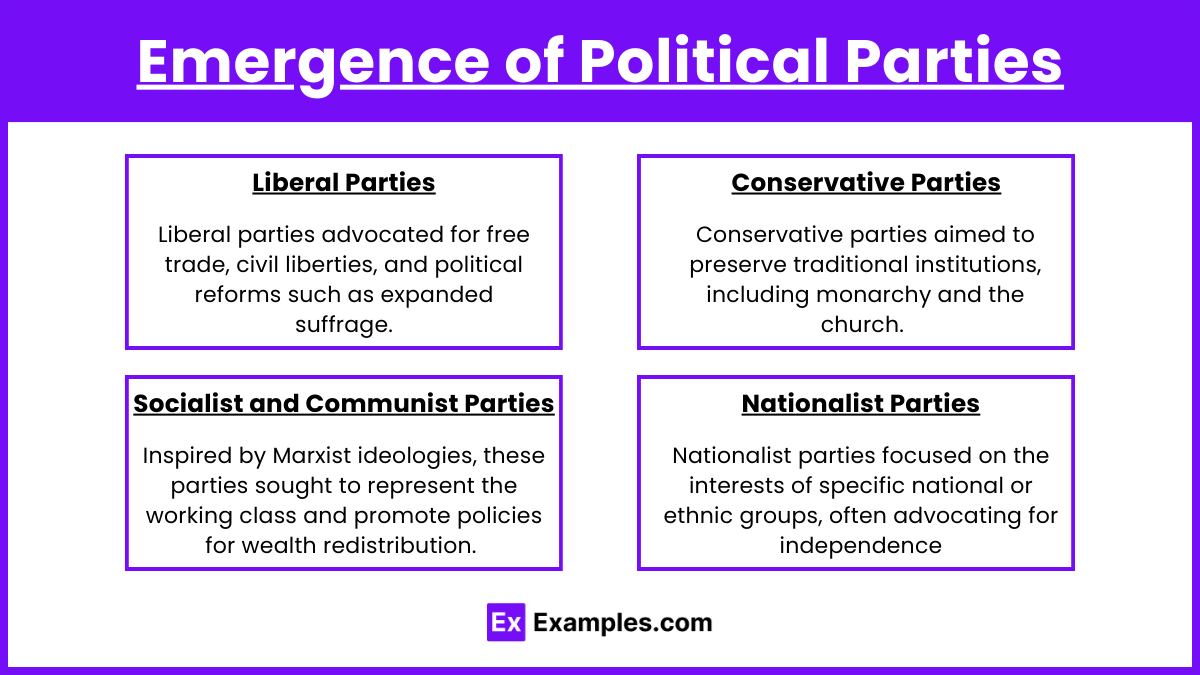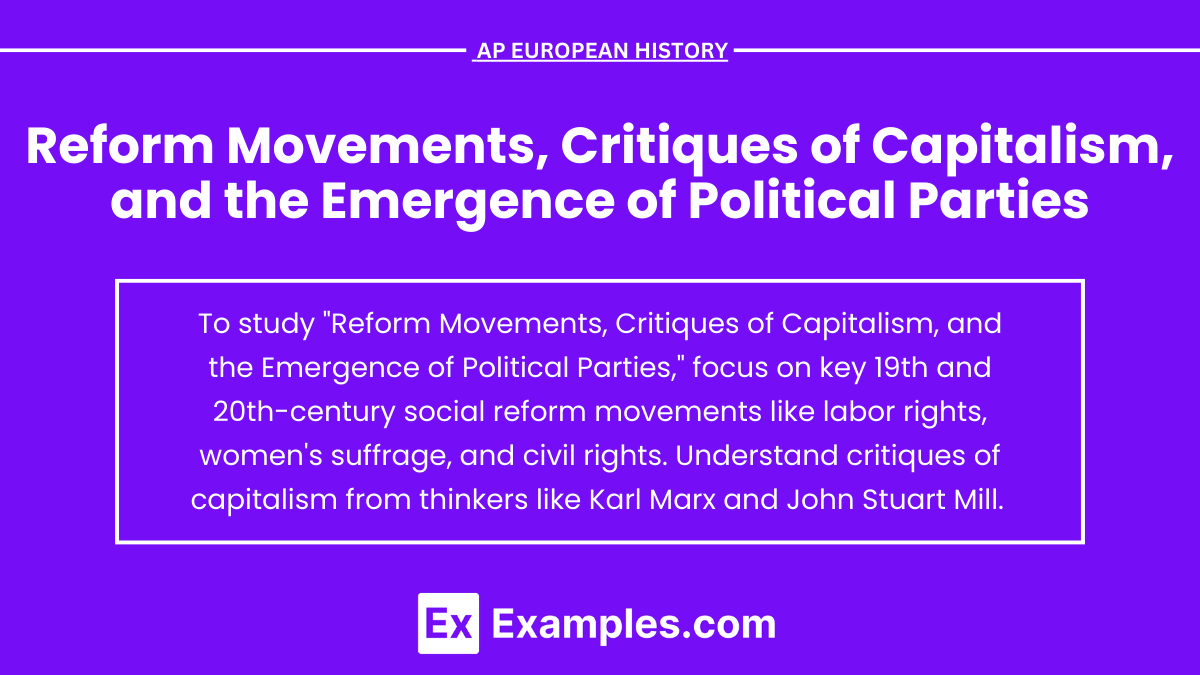The 19th and early 20th centuries in Europe, as studied in AP European History, witnessed profound changes driven by reform movements, critiques of capitalism, and the rise of political parties. These movements emerged in response to the social and economic upheavals of the Industrial Revolution, challenging existing power structures and advocating for labor rights, women’s suffrage, and political representation. The period also saw the birth of socialism and communism, offering alternatives to capitalist systems, and the formation of new political parties that shaped the continent’s political landscape.
Learning Objectives
In studying “Reform Movements, Critiques of Capitalism, and the Emergence of Political Parties” for the AP European History exam, focus on understanding the key social, political, and economic changes in 19th and early 20th century Europe. Learn about major reform movements advocating labor rights, education, and women’s suffrage; critique capitalism through Marxism and utopian socialism; and recognize the rise of political parties, including liberal, conservative, socialist, and nationalist groups. Grasp the ideologies, significant events, and influential figures driving these transformations.
Reform Movements

1. Social Reform Movements
Social reform movements aimed to address inequalities and improve living conditions. Key areas of focus included:
- Labor Rights: The Industrial Revolution led to poor working conditions, prompting movements for shorter workdays, safer working environments, and the right to unionize. The British Factory Acts are notable examples of early labor reform legislation.
- Education: Reformers advocated for public education systems to provide basic literacy and numeracy skills to all children. The expansion of public education in countries like France and Germany was a significant achievement of the period.
- Women’s Rights: The women’s suffrage movement gained momentum, advocating for equal rights for women, including the right to vote, own property, and access education. Figures like Emmeline Pankhurst in the UK and Clara Zetkin in Germany were prominent activists.
2. Political Reform Movements
Political reform movements sought to expand political participation and address issues of governance. Key movements included:
- Liberalism: Advocating for constitutional governments, individual freedoms, and free-market economies, liberalism challenged absolute monarchies and sought to limit state power. The Revolutions of 1848 were a series of republican revolts against European monarchies, largely inspired by liberal ideals.
- Nationalism: Nationalist movements aimed to unite people with shared cultural, linguistic, and historical backgrounds into independent nation-states. This was evident in the unification of Italy and Germany in the 19th century.
- Socialism and Communism: These movements critiqued capitalism and advocated for a more equitable distribution of wealth. The writings of Karl Marx and Friedrich Engels, particularly “The Communist Manifesto,” became foundational texts for socialist and communist ideologies.
Critiques of Capitalism

Capitalism, characterized by private ownership of the means of production and a market-driven economy, was both celebrated and criticized in the 19th and early 20th centuries.
1. Marxism
- Karl Marx and Friedrich Engels: They argued that capitalism inherently led to class struggles between the bourgeoisie (owners of the means of production) and the proletariat (working class). Marx predicted that these tensions would eventually lead to a proletarian revolution and the establishment of a classless, communist society.
- Das Kapital: Marx’s seminal work critiqued the capitalist system’s exploitation of labor and the creation of surplus value, which he believed was the root of all economic inequalities.
2. Utopian Socialism
- Early Socialists: Figures like Robert Owen and Charles Fourier proposed ideal communities where wealth and labor were shared equally. Unlike Marxists, utopian socialists believed that peaceful cooperation could bring about a more equitable society.
- Cooperative Movements: These movements encouraged the establishment of cooperative enterprises, where workers collectively owned and managed businesses.
Emergence of Political Parties

The political landscape of Europe transformed as new parties emerged, often in response to the aforementioned reform movements and critiques of capitalism.
1. Liberal Parties
Liberal parties advocated for free trade, civil liberties, and political reforms such as expanded suffrage. They often represented the interests of the middle class.
2. Conservative Parties
Conservative parties aimed to preserve traditional institutions, including monarchy and the church. They often opposed radical changes and were supported by the aristocracy and landed gentry.
3. Socialist and Communist Parties
Inspired by Marxist ideologies, these parties sought to represent the working class and promote policies for wealth redistribution. The German Social Democratic Party (SPD) was one of the most influential socialist parties of the time.
4. Nationalist Parties
Nationalist parties focused on the interests of specific national or ethnic groups, often advocating for independence or greater autonomy within existing states.
The period between the 19th and early 20th centuries was marked by significant transformations in European society. The rise of reform movements, critiques of capitalism, and the emergence of new political parties reflected the growing demand for political, social, and economic change. These developments laid the groundwork for many of the political ideologies and movements that would shape the 20th century and beyond. Understanding these historical changes is crucial for comprehending the modern political landscape in Europe and the broader world.
Examples
Example 1
Labor Movement & Socialist Party : The labor movement criticized capitalism’s worker exploitation, leading to the creation of socialist parties advocating for workers’ rights and public ownership.
Example 2
Progressive Movement & Progressive Party : The Progressive Movement targeted corporate monopolies and corruption, resulting in the Progressive Party, which pushed for political and economic reforms.
Example 3
Populist Movement & People’s Party : The Populist Movement, responding to farmer hardships, led to the People’s Party, which opposed corporate power and advocated for economic reforms.
Example 4
Green Movement & Green Parties : The Green Movement criticized environmental degradation caused by capitalism, leading to Green Parties that promote sustainability and social justice.
Example 5
Anti-Globalization Movement & Various Parties : The anti-globalization movement opposed neoliberal policies, inspiring parties like Syriza and Podemos, which advocate for economic equity and regulation of corporations.
MCQ’s
Question 1:
Which of the following was a primary criticism of capitalism during the early 19th century reform movements?
A) It led to the expansion of democratic rights.
B) It resulted in increased economic equality among all social classes.
C) It created harsh working conditions and significant wealth disparities.
D) It promoted communal ownership of resources.
Answer: C) It created harsh working conditions and significant wealth disparities.
Explanation: During the early 19th century, reform movements often criticized capitalism for creating stark inequalities in wealth and power. The Industrial Revolution, which was driven by capitalist principles, resulted in the concentration of wealth among factory owners and industrialists, while workers faced poor working conditions, long hours, and low wages. These issues were central to the critiques of capitalism by various reformers and labor activists, who sought to improve the lives of the working class.
Question 2:
Which political party in the United States emerged in the mid-19th century as a response to issues such as the abolition of slavery and economic reform?
A) The Federalist Party
B) The Democratic-Republican Party
C) The Republican Party
D) The Whig Party
Answer: C) The Republican Party
Explanation: The Republican Party was formed in the 1850s in response to issues like the expansion of slavery and the need for economic reforms. The party’s platform included opposition to the spread of slavery into new territories and states, as well as support for economic policies that would benefit the industrial North, such as tariffs and infrastructure improvements. The emergence of the Republican Party reflected broader social and economic debates of the time, particularly regarding the moral and economic dimensions of slavery and industrialization.
Question 3:
The Social Gospel movement, which critiqued the moral implications of capitalism, was associated with which of the following beliefs?
A) Laissez-faire economics and minimal government intervention
B) The application of Christian ethics to social problems
C) The promotion of anarchism and the abolition of all government
D) The rejection of religious influence in public policy
Answer: B) The application of Christian ethics to social problems
Explanation: The Social Gospel movement was a religious movement that emerged in the late 19th and early 20th centuries, advocating for the application of Christian ethics to address social issues. It critiqued the negative impacts of capitalism, such as poverty, inequality, and poor working conditions, and called for reforms based on principles of social justice and compassion. The movement sought to inspire social reform through the teachings of Christianity, emphasizing the need to address the moral and ethical implications of economic systems.


